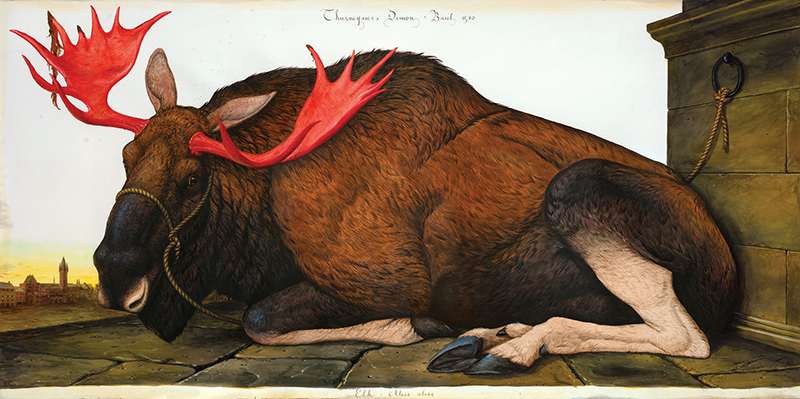
Thurneysser’s Demon, a mixed-media artwork (watercolor, gouache, pencil, and ink on paper), by Walton Ford? © The artist. Courtesy Kasmin Gallery, New York City
Five of six early Homo species were driven to extinction by climate change. Geologists proved the existence of a tectonic plate, long subject to debate, known as Resurrection. Plague spread four times faster in the seventeenth century than in the fourteenth. At the entrance to a cave at Gua Makpan, on Alor Island, the body of a child buried 8,000 years ago was found with ocher pigment on the cheeks and forehead, the arms and legs removed, and an ocher stone under the head. At the 9,000-year-old Wilamaya Patjxa site, a teenage hunter was found buried with her weapons. Whereas a prone burial position in late- and post-medieval German-speaking Europe is thought to indicate that the deceased was deviant, in the earlier Middle Ages it appears to have indicated humility. In graves in the old Yanghai cemetery, near the city of Turpan, the oldest leather balls in Eurasia were found along with one of the oldest known pairs of trousers. Archaeologists announced the discovery of vitrified brain tissue in the ruins of Pompeii. Nineteenth-century metal runoff from the mines of the Isle of Man may be brittling the shells of king scallops, and metals from Chinese coal-fired power plants are nourishing the North Pacific. Zircon crystal evidence suggests the presence of 350 cubic kilometers of magma beneath Xinantecatl, outside Mexico City. Pockets of ice may hide in the shadows of the moon. Astronomers noted the existence of a planet with oceans of lava where it rains rocks. A planet with no solar system was passing through the Milky Way.
Wallabies may be breeding in the wild in Britain. Artificial light may be driving mosquitoes from day-biting to night-biting. Colorado spruce forests killed by beetles become mildly cooler, and Guam’s coconut rhinoceros beetles have started burrowing into cycad trees. Scientists succeeded in using a hydrogel to conduct electrical impulses through the damaged sciatic nerve of a toad, analyzed the testicular tissue of female moles, detailed the role of cryptic sexual pressure on the dimorphism of the Sulawesi babbler, described the interlocking armor plates that make Phloeodes diabolicus uncrushable, and debated where to place Kopidosaurus perplexus on the tree of life. Mathematical biology researchers proposed the first universal scaling law of mammalian touch. A study of humans and common marmosets concluded that basic grammatical capacity is 40 million years old. Boston babies can be lulled by Border Kuna, Cherokee, Hopi, Inuvialuktun, Western Nahuatl, Scottish Gaelic, and Selk’nam lullabies.
Old black Americans are less likely to fall than old white Americans, who are less likely to be injured in a fall than old Native Americans. Hot days worsen test scores for black and Hispanic children. Female surgeons perform less complex surgeries than their male peers. The CDC reported that some high school teachers are unable to differentiate between vape modules and USB drives. The enslavement of Vietnamese nationals on British cannabis farms may be under-recognized. Scientists warned the Australian government not to release carp herpes into wild lakes. South African researchers found that shack fires spread swiftly. Environmental DNA meta-barcoding can effectively survey the fishes of the deep sea, which is warming, slowly. The vaquita shows no evidence of an extinction vortex. British veterinary scientists expressed concern that the booming popularity of brachycephalic dog breeds foretold no bust.




